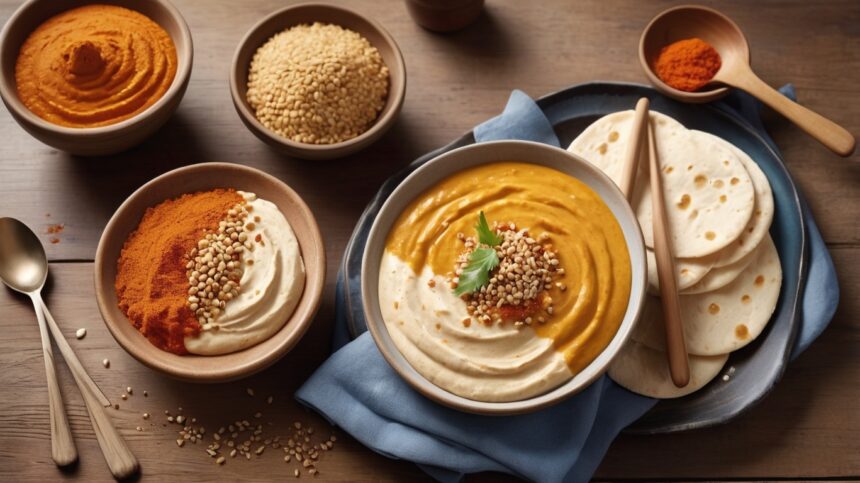Tahhiini is more than just a food ingredient – it is a cultural staple, a nutritional powerhouse, and a culinary secret used across various cuisines. While many people associate it with Middle Eastern dishes, Tahhiini has made its way into kitchens worldwide due to its creamy texture, rich flavor, and impressive health benefits. This article explores its history, production, health benefits, and ways to incorporate it into your diet.
also read: https://usaenliinea.com/bemyexchange/
What is Tahhiini?
Tahhiini is a smooth paste made from ground sesame seeds. It has a nutty flavor, a creamy consistency, and can be used as a dip, spread, or ingredient in various dishes. Depending on the region, it may be made from hulled or unhulled sesame seeds, which affects its texture and nutritional profile.
In Middle Eastern cuisine, Tahhiini is a key ingredient in hummus, baba ghanoush, and halva. Its versatility allows it to be incorporated into both sweet and savory recipes.
History and Cultural Importance of Tahhiini
Tahhiini’s origins date back thousands of years. Historical records suggest that sesame cultivation began in ancient Mesopotamia, and sesame paste was a valued food source due to its high oil content and long shelf life.
In Middle Eastern culture, Tahhiini is often seen as a symbol of hospitality. Serving a dish made with Tahhiini to guests reflects generosity and care. Over time, it spread to Mediterranean, African, and Asian cuisines, each adopting unique methods of preparing and serving it.
How Tahhiini is Made
The process of making Tahhiini is simple but requires quality ingredients and careful preparation:
- Cleaning – Sesame seeds are cleaned to remove dirt, dust, and impurities.
- Hulling – The outer shells may be removed for a smoother texture.
- Roasting – Seeds are lightly roasted to bring out a nutty aroma.
- Grinding – Roasted seeds are ground into a fine paste, sometimes with a little oil to improve consistency.
Table: Tahhiini Production Overview
| Step | Purpose | Effect on Flavor & Texture |
|---|---|---|
| Cleaning | Remove impurities | Ensures purity |
| Hulling | Remove seed shells | Makes smoother paste |
| Roasting | Enhance aroma & flavor | Rich, nutty taste |
| Grinding | Create paste from sesame seeds | Creamy and spreadable |
Nutritional Value of Tahhiini
Tahhiini is packed with essential nutrients that make it both delicious and healthy. A typical serving (2 tablespoons) provides:
- Calories: ~180
- Protein: 5g
- Healthy Fats: 16g (mostly unsaturated)
- Carbohydrates: 4g
- Fiber: 3g
- Vitamins: B1, B2, B3, B6, E
- Minerals: Calcium, magnesium, phosphorus, iron, zinc
It’s also an excellent plant-based protein source, making it perfect for vegetarian and vegan diets.
Health Benefits of Tahhiini
Eating Tahhiini regularly can provide a variety of health benefits:
1. Heart Health
The unsaturated fats in Tahhiini help reduce bad cholesterol (LDL) and increase good cholesterol (HDL), lowering the risk of heart disease.
2. Bone Strength
Tahhiini is rich in calcium and magnesium, both vital for maintaining strong bones and preventing osteoporosis.
3. Digestive Support
The high fiber content supports healthy digestion and prevents constipation.
4. Rich in Antioxidants
Sesame seeds contain lignans, which help fight oxidative stress and inflammation in the body.
5. Supports Hormonal Balance
Sesame lignans may assist in balancing hormones, particularly in women during menopause.
Culinary Uses of Tahhiini
Tahhiini is incredibly versatile in the kitchen. Here’s how it’s commonly used:
In Savory Dishes
- Mixed with lemon juice, garlic, and water to make a creamy sauce for falafel.
- Added to hummus for extra richness.
- Drizzled over roasted vegetables.
In Sweet Recipes
- Combined with honey to make a sweet spread.
- Incorporated into cookies, cakes, and energy bars.
As a Health Boost
- Added to smoothies for extra protein and creaminess.
- Used as a salad dressing base.
Popular Tahhiini Recipes
Here are some classic recipes where Tahhiini shines:
1. Tahhiini Sauce
Mix Tahhiini, lemon juice, garlic, salt, and water until smooth. Perfect as a dip or drizzle.
2. Hummus
Blend chickpeas, Tahhiini, lemon juice, garlic, and olive oil for a creamy, protein-packed dip.
3. Tahhiini Halva
Combine Tahhiini with sugar or honey to create a sweet, crumbly dessert.
Storing and Preserving Tahhiini
Tahhiini can last for months if stored correctly:
- Unopened jar: Keep in a cool, dry place for up to 6 months.
- Opened jar: Store in the refrigerator to prevent oil separation and spoilage.
- Tip: If the oil separates, simply stir before use.
Buying Quality Tahhiini
When shopping for Tahhiini, keep these tips in mind:
- Check ingredients – It should contain only sesame seeds and perhaps a little salt.
- Avoid added oils or sugars – Pure Tahhiini is healthier.
- Choose roasted or raw – Roasted has a stronger flavor; raw is milder.
Tahhiini vs. Other Nut and Seed Butters
| Feature | Tahhiini | Peanut Butter | Almond Butter |
|---|---|---|---|
| Main Ingredient | Sesame seeds | Peanuts | Almonds |
| Flavor | Nutty, slightly bitter | Sweet, earthy | Mild, sweet |
| Fat Content | High, mostly unsaturated | High | High |
| Common Uses | Middle Eastern dishes | Sandwiches, snacks | Smoothies, baking |
FAQs About Tahhiini
Q1: Is Tahhiini gluten-free?
A: Yes, Tahhiini is naturally gluten-free, making it safe for people with celiac disease or gluten sensitivity.
Q2: Can I make Tahhiini at home without a food processor?
A: Yes, though it’s harder. You can grind sesame seeds in a mortar and pestle, but it will take more effort.
Q3: Is Tahhiini suitable for keto diets?
A: Yes, its low carbohydrate content makes it keto-friendly.
Q4: Why does Tahhiini sometimes taste bitter?
A: Over-roasted seeds or unhulled sesame can cause a slightly bitter taste.
Q5: Can Tahhiini be frozen?
A: Yes, freezing can extend its shelf life, but texture may change slightly.
Q6: Is Tahhiini safe for kids?
A: Yes, it’s safe, but check for sesame allergies first.
Q7: Can I use Tahhiini instead of peanut butter?
A: Yes, it works as a nut-free alternative in most recipes.
Q8: Does Tahhiini help with weight loss?
A: In moderation, yes, because it’s nutrient-dense and helps keep you full.
Q9: Can Tahhiini be eaten raw?
A: Yes, it’s delicious raw, straight from the jar.
Q10: Is Tahhiini vegan?
A: Absolutely, it’s made entirely from plant-based ingredients.
Conclusion
Tahhiini is a flavorful, nutritious, and versatile ingredient that has been cherished for centuries. From its rich history to its numerous health benefits and endless culinary applications, it’s a staple worth keeping in every kitchen. Whether you enjoy it in hummus, drizzled over vegetables, or baked into desserts, Tahhiini offers both taste and nutrition in every spoonful.
also read:https://usaenliinea.com/susbluezilla/
also read: https://usaenliinea.com/ttps-docs-google-com-document-pii-deleted-2/
also read: https://usaenliinea.com/pappedeckel/
also read: https://usaenliinea.com/trucofax/
also read: https://usaenliinea.com/jhonbaby777/
also read:https://usaenliinea.com/hms-photovoltaik/
also read: https://usaenliinea.com/taboofantazy/
also read: https://usaenliinea.com/fsi-blogs-us-the-ultimate-resource-for-financial-services-insights/







